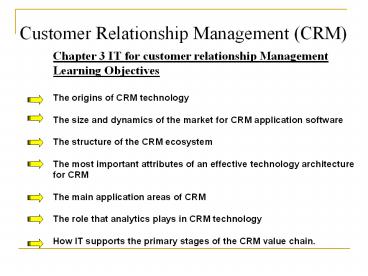Customer Relationship Management (CRM) PowerPoint PPT Presentation
Title: Customer Relationship Management (CRM)
1
Customer Relationship Management (CRM)
Chapter 3 IT for customer relationship
Management Learning Objectives The origins of
CRM technology The size and dynamics of the
market for CRM application software The
structure of the CRM ecosystem The most
important attributes of an effective technology
architecture for CRM The main application areas
of CRM The role that analytics plays in CRM
technology How IT supports the primary stages of
the CRM value chain.
2
Work Flow
3
- Work Flow
- Escalation
- if service call is old and with high severity
and customer is high values then refer it to
service manager - Process automation
- automatically respond email
- Assignment
- product being offered, the territory, current
work load of sales persons, and assign the lead - Dialogue Scripting
- when the customer calls in a welcoming standard
script should be given - Process navigation
- navigate the user to customer identification
screen - Integration
- confirmed order should be verification and
dispatch.
4
Integration Integration is a major IT topic in
its own right. Specialist integration middleware
providers such as Webmethods, IBM (MQSeries),
SeeBeyond, Vitria and Tibco play an essential
role in large-scale, complex CRM projects. Two
main types of integration batch and real time.
5
Batch Batch processing is technically simpler
than real time, and can handle larger volumes
with less impact on system performance. Batch
processing stores information up in a file or
batch, then moves the information across the
interface into the destination system in one go.
The cost, however, is the delay in moving the
information. Many batch processes only run
overnight, meaning that the information is always
a day old in the destination system.
International organizations that trade across
time zones face a more complicated task in that
batch processing has to be synchronized with
night-time in different geographies. In
general, it is preferable to use batch
integration where it will suffice for example,
when transferring information that does not
change often, such as part number details.
6
Real Time Some integration situations require
real-time integration. Real-time integration
takes place immediately for example, once a
customer record is updated in one system, the
change is immediately reflected in the
destination system. The integration process can
be managed and assured using verification or
queuing management technology, to ensure
that integration messages are not lost. Some
forms of integration, such as telephony
integration, must always be real time, as the
customer is on the phone at the time.
7
Whatever the integration technology, however, CRM
generally requires up to four areas of
integration Application Integration other
business systems such as accounting, billing,
inventory and human resources Telephony
Integration Telephony integration ties the CRM
application in to the telephone system, allowing
inbound calls to be routed to the right person
based on caller details, and outbound calls to be
automatically made from the call-centre desktop E-
mail and web integration
8
- CRM Application
- Customer relationship management applications are
generally organized - into the primary functions of marketing, sales
and service. - Customer and product Management
- Customer and product management may be separate
areas of a CRM application, or they may be built
in to sales, service or marketing. In either
case, it is essential that products and customers
be adequately modelled in the application. - Business-to-business (B2B) customers may have
complex buying organizations and structures, or
consumers (B2C) may live in, and move,
households. Products may either be simple retail
items or require complex configuration rules
(e.g. an automobile with certain engine options,
colour schemes, tyre options and accessories).
9
(No Transcript)
10
CRM components Products industry or company
specific
11
CRM components Marketing
12
- Thank You!!!
- QA

